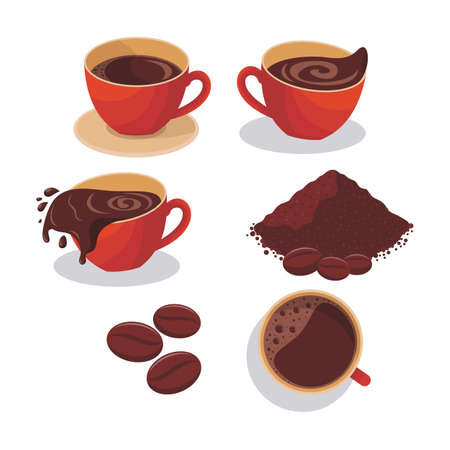1. Understanding the Basics of AeroPress Brewing
The AeroPress is a favorite among coffee lovers in the U.S. for its portability, quick brew time, and ability to produce a smooth, flavorful cup. But one of the most important — and often overlooked — factors in getting that perfect cup is dialing in your grind size.
How the AeroPress Works
The AeroPress uses pressure and immersion to extract flavor from coffee grounds. You add ground coffee and hot water into a chamber, stir it for a few seconds, then press the plunger down to push the brewed coffee through a filter and into your mug. This short contact time means you have less room for error — especially when it comes to grind size.
Why Grind Size Matters
Your grind size directly affects how your coffee tastes. If your grind is too fine, your brew might taste bitter or over-extracted. If its too coarse, it can be sour or weak because the water didnt have enough surface area to pull out all those tasty flavors. Finding the right balance is key.
Grind Size vs. Flavor Profile
| Grind Size | Extraction | Flavor Notes |
|---|---|---|
| Fine (like table salt) | High extraction | Bold, sometimes bitter |
| Medium-Fine (like sand) | Balanced extraction | Smooth, full-bodied |
| Coarse (like kosher salt) | Low extraction | Mild, sometimes sour |
Pro Tip:
If youre using store-bought pre-ground coffee, chances are its too fine or too coarse for an ideal AeroPress brew. Invest in a burr grinder to control your grind size and dial in your perfect cup every time.
2. Choosing the Right Coffee Beans
Before you even think about adjusting your grind size for AeroPress, it’s important to start with the right coffee beans. The roast level, origin, and freshness of your beans all play a key role in how you should dial in your grind for that perfect cup.
Roast Level Matters
The roast level of your coffee affects how easily it extracts during brewing. Heres a quick guide:
| Roast Level | Grind Recommendation | Taste Notes |
|---|---|---|
| Light Roast | Finer grind | Bright, acidic, fruity |
| Medium Roast | Medium-fine grind | Balanced, sweet, smooth |
| Dark Roast | Coarser grind | Bitter, smoky, chocolatey |
Bean Origin and Its Impact on Grind
Coffee beans from different regions have unique characteristics that can affect how they extract. For example:
- African beans (like Ethiopian or Kenyan): Often more delicate and complex—try a slightly finer grind to highlight floral or fruity notes.
- Latin American beans (like Colombian or Guatemalan): Balanced and versatile—good with a medium-fine grind.
- Indonesian beans (like Sumatran): Earthy and bold—use a slightly coarser grind to avoid over-extraction.
The Importance of Freshness
Freshly roasted coffee makes a huge difference in flavor and extraction. Beans start to lose their aromatics quickly after roasting. Ideally, use beans within 2–4 weeks of roast date. If your beans are too fresh (less than 3 days), they may still be degassing and could throw off your brew. On the other hand, stale beans may require a finer grind to compensate for reduced flavor.
Tips for Buying Fresh Beans:
- Check the roast date on the bag—not just the “best by” date.
- Avoid pre-ground coffee if possible; grinding just before brewing gives better results.
- Buy from local roasters or trusted specialty shops that rotate stock frequently.
Putting It All Together
Selecting the right beans sets the stage for a great AeroPress experience. Once you’ve picked your roast and origin, adjust your grind accordingly to bring out the best flavors in every cup.
![]()
3. Grind Size Demystified
When it comes to brewing coffee with an AeroPress, grind size plays a huge role in determining how your final cup tastes. Whether youre aiming for something bold and rich or smooth and clean, dialing in the right grind can make all the difference.
Understanding Grind Sizes
Grind size refers to how coarse or fine your coffee grounds are. Think of it like breadcrumbs—some are powdery like flour, others chunky like sea salt. Each level of grind affects how fast water flows through the coffee and how much flavor is extracted.
Common Grind Sizes and Their AeroPress Impact
| Grind Size | Texture Comparison | AeroPress Result | Recommended Brew Style |
|---|---|---|---|
| Extra Fine | Powdered sugar | Over-extracted, bitter; clogs filter | Not recommended for AeroPress |
| Fine | Table salt | Strong and rich; quicker brew time | Espresso-like brews, short steep times (inverted method) |
| Medium-Fine | Sand | Balanced flavor; good clarity and body | Standard AeroPress recipes (1–2 min steep) |
| Medium-Coarse | Rough sand or kosher salt | Milder taste; may under-extract if brewed too quickly | Longer steep methods (up to 4 min) |
| Coarse | Sea salt or cracked peppercorns | Weak flavor; under-extracted unless steeped very long | Rarely used with AeroPress, better for French press or cold brew |
So, Whats the Sweet Spot?
If youre new to AeroPress, starting with a medium-fine grind is usually your best bet. It gives you a balanced cup without clogging the filter or making your brew too bitter. From there, you can tweak the grind finer or coarser depending on whether you want more strength or more clarity.
Troubleshooting Tips Based on Grind Size:
- Bitter or harsh taste? Try using a slightly coarser grind.
- Sour or weak flavor? Go finer to increase extraction.
- Takes too long to press? Your grind might be too fine—adjust coarser.
- Coffee rushes through too fast? Go finer to slow down extraction.
The beauty of the AeroPress is its flexibility. Once you understand how grind size shapes your brew, you’re well on your way to crafting that perfect cup every time.
4. How to Dial In Grind Size for AeroPress
Getting the grind size just right is one of the most important steps in brewing a great cup of coffee with your AeroPress. Since this method uses pressure and a short brew time, having the correct grind ensures balanced extraction—too fine and it gets bitter; too coarse and it tastes weak. Heres a step-by-step guide to help you dial in your grinder for that perfect AeroPress brew.
Step 1: Know Your AeroPress Style
Before adjusting your grinder, decide which AeroPress method youre using. There are two main approaches:
- Standard Method: Coffee goes in first, followed by water. Plunge after steeping.
- Inverted Method: AeroPress is flipped upside down. Coffee steeps longer before flipping and plunging.
The inverted method often works better with slightly coarser grinds due to the longer steep time.
Step 2: Start With a Baseline Grind
For most AeroPress brews, youll want a medium-fine grind—about the texture of table salt. If youre using a burr grinder with numbered settings, start at a setting similar to drip coffee and adjust from there.
Grind Size Texture Guide
| Grind Level | Texture Description | AeroPress Suitability |
|---|---|---|
| Fine (like powdered sugar) | Very smooth, clumps easily | Too fine – can clog filter, bitter taste |
| Medium-Fine (like table salt) | Slightly gritty but not coarse | Ideal starting point |
| Medium (like beach sand) | Noticeably gritty but uniform | Might under-extract – good for longer steeps |
Step 3: Brew and Time Your Extraction
Once youve ground your coffee, brew a cup using your preferred AeroPress recipe. Use a timer to track how long it takes to press down the plunger. This helps diagnose if your grind needs adjustment.
Brew Timing Tips
- If it plunges too fast (under 20 seconds): Grind is likely too coarse. Try a finer setting.
- If its hard to press or takes over 45 seconds: Grind may be too fine. Go slightly coarser.
- Smooth press around 25–35 seconds: Youre probably in the sweet spot!
Step 4: Taste and Adjust
Tasting is key. A well-dialed-in grind should give you a balanced cup—bright but not sour, rich but not bitter. Here’s how to fine-tune:
If Your Coffee Tastes…
| Taste Profile | Likely Cause | Adjustment Needed |
|---|---|---|
| Sour or underwhelming | Under-extraction | Use a finer grind or brew longer |
| Bitter or dry finish | Over-extraction | Use a coarser grind or shorten brew time |
| Bland or watery | Grind too coarse or not enough coffee used | Tighten grind setting slightly or increase dose |
Step 5: Keep Notes for Consistency
Coffee changes day by day, especially with different beans. Keep track of what grind setting worked best, how long it brewed, and how it tasted. Over time, youll find dialing in becomes second nature—and every AeroPress cup will be just how you like it.
A calibrated grinder matched to your AeroPress style will bring out the best in your beans every time you brew.
5. Troubleshooting Common Brew Issues
If your AeroPress coffee doesn’t taste quite right, chances are your grind size is the culprit. Adjusting the grind can help you fix common issues like bitterness, sourness, or a weak cup. Heres how to identify and correct these problems.
Common AeroPress Problems and Grind Adjustments
Here’s a quick guide to help you diagnose what’s going wrong with your brew and how to fix it by tweaking the grind size:
| Issue | What It Tastes Like | Likely Cause | Grind Adjustment |
|---|---|---|---|
| Under-extracted Coffee | Sour, sharp, or overly acidic flavors | Grind too coarse | Use a finer grind to increase extraction |
| Over-extracted Coffee | Bitter, harsh, or dry aftertaste | Grind too fine | Use a coarser grind to reduce extraction |
| Weak or Watery Coffee | Lacks flavor and body | Grind too coarse or not enough coffee used | Try a slightly finer grind and make sure youre using the right coffee-to-water ratio |
| Clogged Filter or Hard to Press | Takes a lot of force to press down | Grind too fine or using very fresh coffee that expands a lot | Use a slightly coarser grind or reduce dose slightly |
Tips for Better Consistency
- Use a burr grinder: Burr grinders provide consistent particle sizes, which helps you dial in your brew more accurately.
- Weigh your coffee: Always measure both coffee and water for repeatable results.
- Tweak one variable at a time: Change only the grind size first before adjusting other variables like steep time or water temperature.
- Keep notes: Jot down what grind setting you used and how the coffee tasted. It’ll help you improve faster.
A little bit of trial and error goes a long way with the AeroPress. Once you learn how to adjust your grind based on taste, youll have way more control over your brew—and better coffee every morning.
6. Experimenting with Recipes and Techniques
Once youve got a feel for dialing in your grind size, its time to have some fun and get creative with different AeroPress recipes and methods. The great thing about the AeroPress is how flexible it is—you can tweak the grind size, water temperature, brew time, and even the brewing position to suit your taste.
Try the Inverted Method
The inverted method flips the AeroPress upside down during brewing, which gives you more control over steeping time and prevents early dripping. This method works great with slightly coarser grinds than usual, especially if youre aiming for a fuller-bodied cup.
Suggested Grind Size for Inverted Method:
| Grind Level | Description | Brew Result |
|---|---|---|
| Medium-Coarse | Similar to sea salt | Richer body, slower extraction |
| Medium | Like regular sand | Balanced flavor and clarity |
Make It Cold with an Iced Brew
If youre craving something refreshing, try making an iced AeroPress coffee. Use a finer grind for a quick extraction and press directly over ice. The result? A bright and crisp cold coffee that’s perfect for hot days.
Suggested Grind Size for Iced Brew:
| Grind Level | Description | Brew Result |
|---|---|---|
| Medium-Fine | Slightly finer than table salt | Quick extraction, vibrant flavors |
| Fine | Similar to powdered sugar | Strong and intense brew, best over lots of ice |
Dont Be Afraid to Mix Things Up
The key to mastering your AeroPress grind is experimentation. Try different recipes, change up your technique, and see how your coffee evolves. Whether youre flipping it upside down or chilling it over ice, adjusting your grind size is one of the easiest ways to discover new flavor profiles and find what works best for your personal taste.


